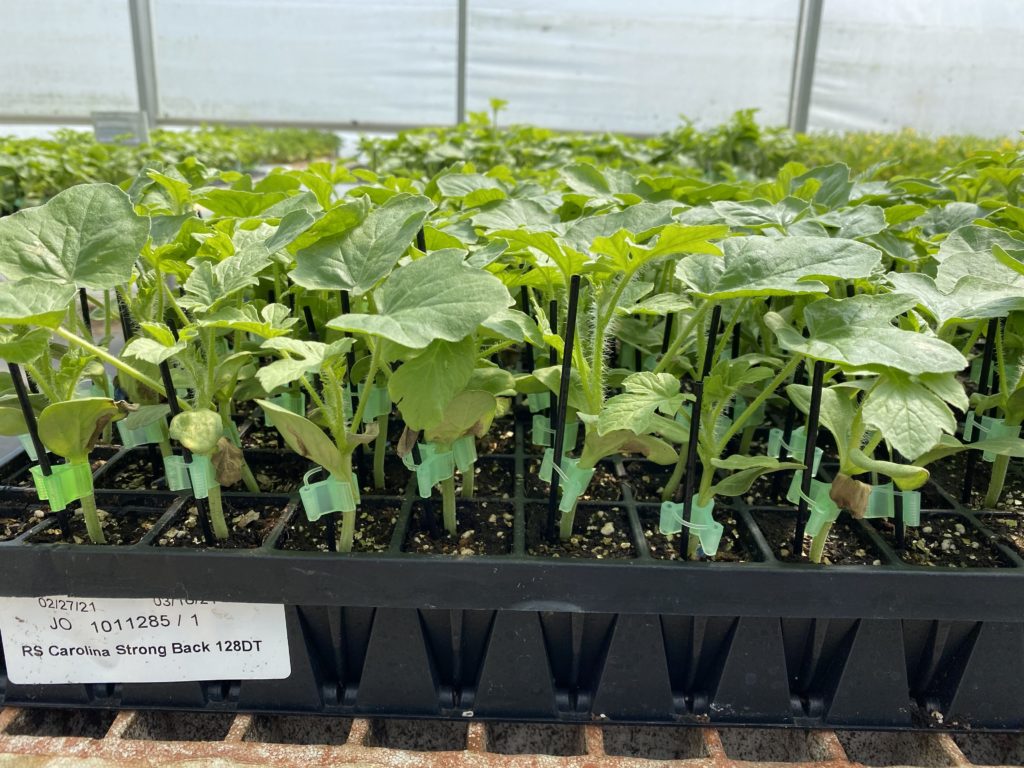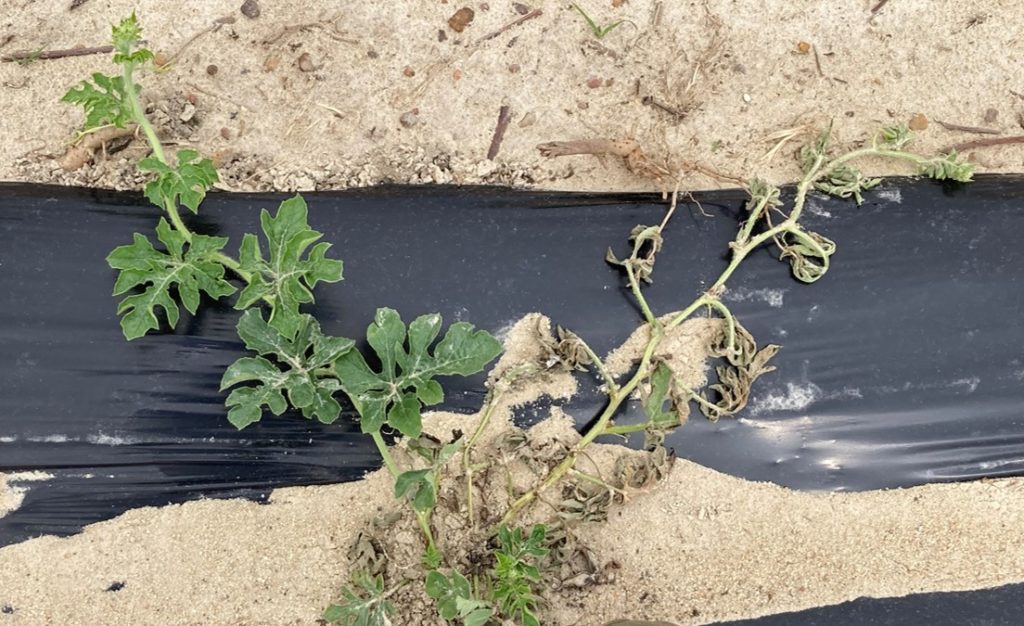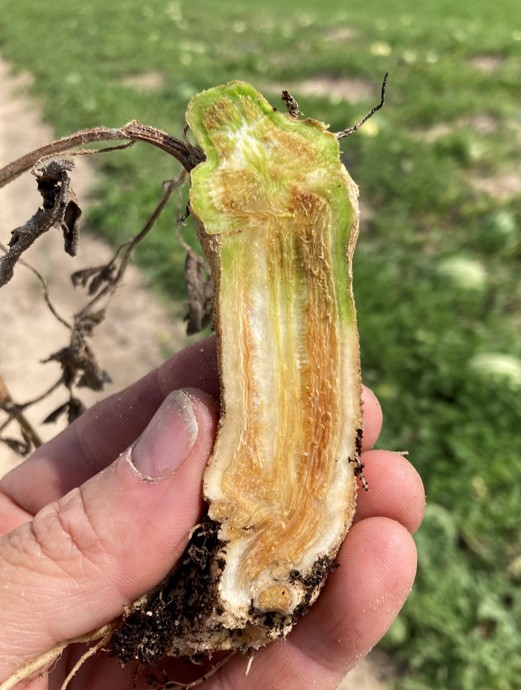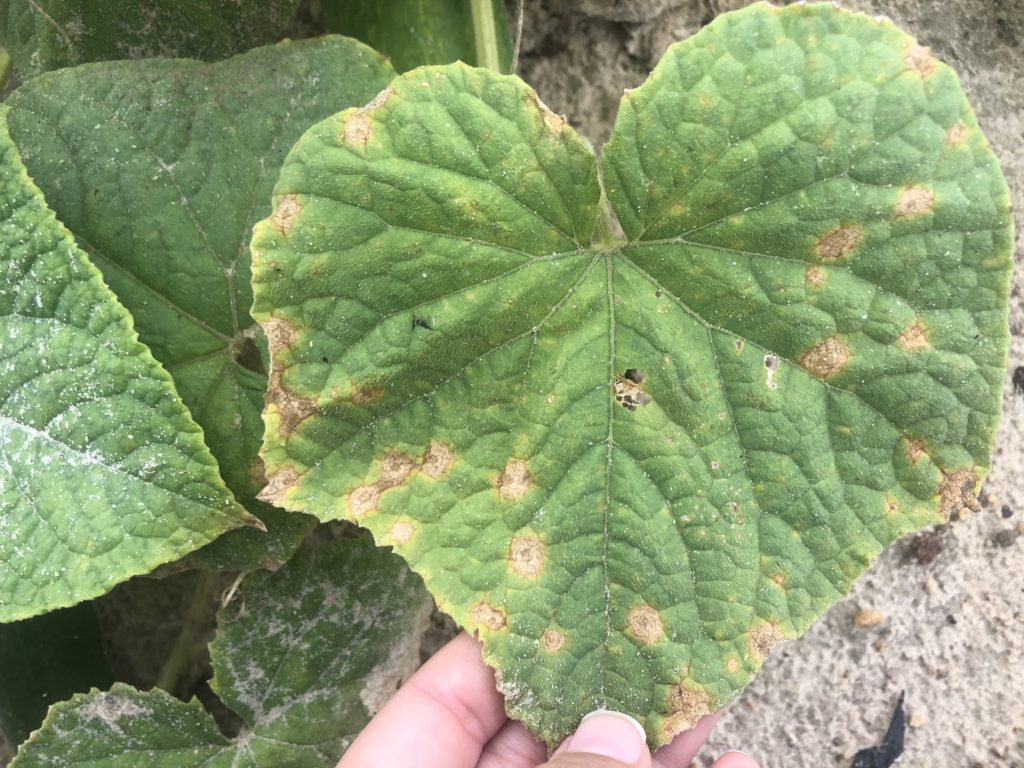By Bhabesh Dutta
Cucurbit production in Georgia is affected annually by a variety of pests and diseases. Two diseases in particular, fusarium wilt and cucurbit anthracnose, have been a cause of concern for the last five years. This article gives a brief update on the progress the University of Georgia (UGA) vegetable team1 of scientists has made studying these diseases during the last few years. The outcomes discussed in this research were also developed and optimized with close collaboration from a group of county Extension agents2 in Georgia.

FUSARIUM WILT
Fusarium wilt continues to cause considerable economic losses annually in watermelon. The causal agent is a pathogen that is soil-borne and specific to watermelon. The pathogen is specialized to watermelon and seldom causes disease on other cucurbit crops. The pathogen can survive indefinitely in infested soil, so common crop-rotation practices may not be useful. Due to this logistic issue, there are not many fields left for watermelon growers in some counties in southern Georgia to rotate with.
Management of this disease relies on fungicide application, particularly prothioconazole (Proline), which needs to be applied in soil either right at or close to planting. Foliar application of Miravis Prime 10 to 14 days after Proline application may provide a boost against fusarium wilt. However, under certain conditions, this boost in efficacy is a little difficult to interpret.

Using funds from the Specialty Crop Block Grant, the vegetable team also assessed a new rootstock, Carolina Strongback (CSB), in a multiyear, multicounty trial. Seedless scion grafted on CSB rootstock had significantly lower fusarium wilt incidence compared with the non-grafted seedlings and other appropriate experimental controls. The team will continue to optimize other agronomic and horticultural parameters with the aim of economic viability for watermelon growers. The team has been collaborating closely with Tri-Hishtil and will continue to screen rootstocks against fusarium wilt.
The vegetable team will evaluate different commercially available cucurbit rootstocks against fusarium wilt and rootknot nematode under controlled greenhouse and field conditions. It will determine optimum row-spacing and fertility programs for the top-performing rootstocks with grafted seedless watermelon. Economic analysis will be conducted to determine profitability of the optimized system(s) compared to current practices. Outreach efforts will deliver knowledge to growers and industry professionals.

CUCURBIT ANTHRACNOSE
Cucurbit anthracnose, particularly in cucumber, cantaloupe and squash, has been a concern for the last four years. The problem has become increasingly worse each season in Georgia. On watermelon, the disease has caused only limited damage, probably because the range of fungicides and aggressive programs growers follow have been instrumental in keeping it at bay.
The causal organism of cucurbit anthracnose is a fungal organism called Collectotrichum orbiculare. The pathogen can survive on cucurbit weed hosts and host debris and also can be seed-borne. However, it is difficult to point to either of the sources of inoculum as the reason for the seasonal outbreaks. The vegetable team found that most of the fungal isolates that were collected from the outbreaks in different cucurbit crops belonged to C. orbiculare. Other Collectotrichum species were not found in these outbreaks.

Testing with a commonly used fungicide against anthracnose, Quadris (azoxystrobin), under lab conditions indicated significantly reduced sensitivity. These lab observations corroborated field observations where fungal insensitivity to Quadris was consistent and widespread.
The team also finished a three-year fungicide trial at UGA-Tifton. The outcomes of these trials indicate that fungicides like Proline, Topsin, Miravis Prime, Luna Experience and Aprovia Top were highly effective against this fungal pathogen. Other fungicides like Bravo and Cabrio were moderately to less effective against the anthracnose pathogen. Combining effective fungicides in a program that keeps post-harvest intervals in mind will help cucurbit growers reduce severity of this disease.
Interestingly, tank-mixing Microthiol sulfur with Proline provided a boost to the efficacy of Proline against anthracnose. Surprisingly, disease severity with Proline with Microthiol sulfur was significantly reduced compared with Proline alone.
To improve management strategies, the vegetable team will attempt to understand the pathogen population biology of emerging anthracnose epidemics of cucurbit crops not only in Georgia but also in the eastern United States. The team will examine how soil- and seed-borne inoculum, production practices (e.g., including drip vs. overhead irrigation), fungicide programs, host response in varietal selections and seed treatments contribute to cucurbit anthracnose outbreaks. The goal is to develop pre- and post-harvest management programs that are environmentally and economically viable.
Bhabesh Dutta is an Extension vegetable pathologist and an associate professor at UGA-Tifton.
1The UGA vegetable team, led by the author, includes Ted McAvoy, Extension vegetable specialist; Tim Coolong, Extension organic vegetable specialist; Stormy Sparks, Extension vegetable entomologist; and Stanley Culpepper, Extension vegetable weed specialist.
2This group of Georgia Extension agents includes Josh Grant, Ty Torrance, Tucker Price, Cale Cloud, Guy Hancock, John Bennett, Ben Reeves, Justin Shealey, Josh Dawson and Michasia Dowdy.









